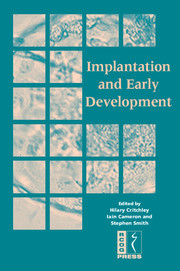Book contents
- Frontmatter
- Contents
- DECLARATION OF INTEREST
- Participants
- Preface
- SECTION 1 PREPARATION FOR IMPLANTATION – THE UTERINE ENVIRONMENT
- SECTION 2 THE EMBRYO
- SECTION 3 LESSONS FROM ANIMAL MODELS (TRANSGENICS) AND NOVEL TECHNOLOGIES
- 15 To implant or not to implant: the role of leukaemia inhibitory factor
- 16 are gene arrays useful for the study of implantations?
- SECTION 4 CLINICAL SEQUELAE
- SECTION 5 CONSENSUS VIEWS
- Index
15 - To implant or not to implant: the role of leukaemia inhibitory factor
from SECTION 3 - LESSONS FROM ANIMAL MODELS (TRANSGENICS) AND NOVEL TECHNOLOGIES
Published online by Cambridge University Press: 05 June 2014
- Frontmatter
- Contents
- DECLARATION OF INTEREST
- Participants
- Preface
- SECTION 1 PREPARATION FOR IMPLANTATION – THE UTERINE ENVIRONMENT
- SECTION 2 THE EMBRYO
- SECTION 3 LESSONS FROM ANIMAL MODELS (TRANSGENICS) AND NOVEL TECHNOLOGIES
- 15 To implant or not to implant: the role of leukaemia inhibitory factor
- 16 are gene arrays useful for the study of implantations?
- SECTION 4 CLINICAL SEQUELAE
- SECTION 5 CONSENSUS VIEWS
- Index
Summary
Introduction
Embryo implantation in the uterus is a unique feature of mammalian reproduction and a tightly regulated process. Changes in ovarian steroids during the pre-implantation period instigate the maturation of the endometrial epithelium and stroma required for implantation to occur in all mammals. In rodents, following priming with pre-ovulatory oestrogen, increased ovarian progesterone produces a sensitised uterus, which becomes receptive to interaction with the blastocyst after a subsequent small transient increase in oestrogen. Implantation is restricted to a short period of the reproductive cycle, the receptive period, which is about 18—24 h in rodents and probably several days in the human. Experimentally, the amount of oestrogen given can influence the duration of the receptive phase. The endometrial response involves differentiation of the endometrial epithelium and stroma to facilitate implantation and allow interaction with the blastocyst trophectoderm. It is the luminal epithelium (LE) with which the trophectoderm of the activated blastocyst first interacts and the epithelial changes are essential for the initiation of implantation.
For successful completion of implantation and placenta formation, the steroid-prepared stroma must undergo a process of further differentiation, known as decidualisation, triggered by blastocyst signals. This requires an embryonic signal (or artificial mimic) and is induced in stroma around the implantation site from late day 4 of pregnancy in mice. In women, decidualisation can occur in the absence of an embryo.
Keywords
- Type
- Chapter
- Information
- Implantation and Early Development , pp. 185 - 202Publisher: Cambridge University PressPrint publication year: 2005



